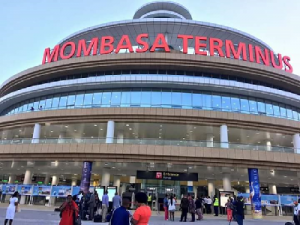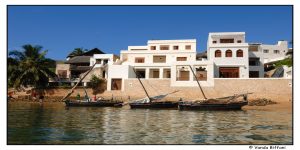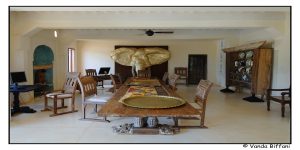The small island of Lamu, northeast of Mombasa, oozes old world charm. A UNESCO World Heritage Site, Lamu Old Town is Kenya’s oldest continually inhabited settlement with origins dating back to the 12th century. Strolling the labyrinthine streets, visitors will see the island’s rich trading history reflected in the buildings. Architectural features from the Arab world, Europe, and India are evident, yet with a discernible Swahili technique. Intricately carved wooden doors, coral stone buildings, hidden courtyards, verandas, and rooftop patios are common features. Visiting here is like stepping back in time. Dhows plow the harbor, few if any motorized vehicles exist here, and donkeys still rule the streets as they have done for centuries.
 Most of Lamu’s population is Muslim and both men and women dress in traditional attire. Top attractions on the island include Lamu , too much, visitors can bask on one of the island’s white sand beaches or sip Arabic coffee in a local café.
Most of Lamu’s population is Muslim and both men and women dress in traditional attire. Top attractions on the island include Lamu , too much, visitors can bask on one of the island’s white sand beaches or sip Arabic coffee in a local café.
Location: 341 km northeast of Mombasa
Lamu is a place like no other, a peaceful tropical island where life is lived at it’s own relaxed rhythm, but a place whose history is as mysterious and fascinating as the winding streets of it’s medieval stone town.
 The island itself is a beautiful place of rolling dunes and endless beaches, where tiny villages nestle among coconut and mango plantations and lateen sailed dhows ply the waters. But Lamu’s real attraction is its Old town.
The island itself is a beautiful place of rolling dunes and endless beaches, where tiny villages nestle among coconut and mango plantations and lateen sailed dhows ply the waters. But Lamu’s real attraction is its Old town.
The town of Lamu began life as a 14th century Swahili settlement, but the island has seen many visitors and influences, including Portuguese explorers, Turkish traders and the Omani Arabs. All left their mark, but Lamu developed its own particular culture, which has ultimately endured.
Lamu’s narrow streets remain unchanged, and in the markets and squares around the fort life moves at the same pace as it always has. There are no vehicles on this island, and the donkey and the dhow remain the dominant form of transport.
The people of Lamu are great believers in tradition and custom, and this is a strong society built on a respect for the past.
For the traveller, Lamu is a hypnotically exotic experience, made even more enjoyable by the relaxed and welcoming attitudes of the locals. To visit Lamu is to enter another world, and the visitor finds themselves becoming a part of this world. Life slows down, and long days are spent strolling along the waterfront, exploring the town or relaxing on the beaches.
Dhow safaris can take you beyond Lamu into the surrounding archipelago, where isolated villages, ancient ruins and a few luxurious and exclusive resorts lie hidden among the islands of Manda, Siyu, Pate and Kiwayu.
This idyllic island speaks to the heart and soul, and a trip to Lamu is a romantic experience that can become a lifelong affair.
Getting There
 Lamu is best accessed by air. There are scheduled flights daily from Nairobi, Mombasa, Diani Beach and Malindi. The island is serviced by an airstrip on neighbouring Manda Island. The strip can also be used by private charters. A dhow ferries arriving passengers to either Lamu town or Shela. Many yachts also come to Lamu, often sheltering in the channel near Shela.
Lamu is best accessed by air. There are scheduled flights daily from Nairobi, Mombasa, Diani Beach and Malindi. The island is serviced by an airstrip on neighbouring Manda Island. The strip can also be used by private charters. A dhow ferries arriving passengers to either Lamu town or Shela. Many yachts also come to Lamu, often sheltering in the channel near Shela.
Getting Around
There are no vehicles on Lamu. The winding streets of the towns are best explored on foot. Shela village and the beaches are also accessible by foot and you can take your baby beach tents there. Alternatively dhows regularly carry paying passengers back and forth from Lamu town to Shela. To access the surrounding islands of Manda, Pate or Siyu, either take an organized Dhow Safari or for the adventurous traveller, just hitch a ride on a passing dhow and explore. It is also possible to hire donkeys to ride around the island.
Protection and management requirements
Lamu Old Town is managed by the National Museums and Heritage Act 2006 (that replaced the 1983 National Museums Act CAP 216 and Antiquities and Monuments Act CAP 215) and the Local Governments Act (and the associated by laws). Physical construction is also subjected to the EMCA Act and the 2006 Planning Act, which recognize that archaeology is material for consideration. The Old Town has a gazetted buffer zone that includes the Manda and Ras Kitau mangrove skyline and the Shela sand dunes, also protected by the Forest Act and Water Act respectively (although the buffer zone has not been formally approved by the World Heritage Committee). All the components are legally protected.
The Lamu Stone Town Conservation Office, now renamed the Lamu World Heritage Site and Conservation Office, was established by the National Museums of Kenya and has been in operation since 1986. A conservation officer is seconded to Lamu County Council to advice on conservation matters. A planning commission exists since 1991 to play a supervisory role and address emerging issues in the conservation area.





